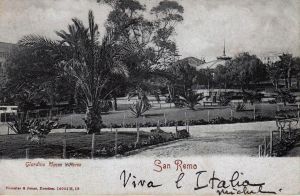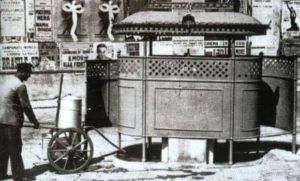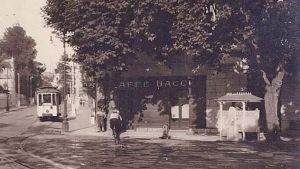4 - Public lavatories
The Municipal Council of 14 June 1872 approved the construction of public lavatories (vespasiani) to be placed at the railway station, in the public garden, on Piazza Colombo, along  Via Vittorio Emanuele, and elsewhere the Municipal Council deemed necessary.
Via Vittorio Emanuele, and elsewhere the Municipal Council deemed necessary.
It was suggested that they should be built "with a garret like those seen in Nice".
In 1885, on the occasion of the renewal of the contract for the distribution of chairs in the public gardens, the contractor was asked to take care of the public toilets built in the Maria Vittoria garden.
At the meeting of the Municipal Council on 5 June 1891, the Councillor for Public Works, Giacomo Picconi, gave a brief report on the proposal by the Italian representative of the "Compagnie nouvelle des chalets de commoditè", based in Paris, to obtain a 30-year licence
« to establish and operate in the city a pavilion or kiosk for the use of public latrines, and two luminous columns with compartments for urinals.
The referent shows how with one and the other the intention is to meet a felt need, and how the two types of construction correspond fully to the purpose. The Society would provide for their construction and operation by means of an annual grant, while the Municipality would provide the necessary water and gas. The annual expense would be about £600; after 30 years, the kiosk and columns would pass into the ownership of the Municipality without any further expense.
The latrine would be located on the corner of Piazza Mercato, facing the Education Building, so that it would not present any inconvenience, even if the square itself were to be enlarged.
He then proposes to approve in principle the installation of the latrine and the two urinals, and to instruct the Council to prepare a special agreement, to be presented in due course to the Council for approval ».
Pio Carli and Antonio Rubino, the councillors, find the proposal perfectly acceptable, but before binding the Municipality with a long-term concession, they would like a special experiment to be carried out.
« Since no doubts could arise regarding the good outcome of the proposed system, such as the one that is in use and has proved its worth in the most important cities, especially in Paris, Picconi does not see how reasonable it is to expect the Company to incur a very considerable expense under the condition of a trial, and therefore insists on the proposal ». The President comm. Bartolomeo Asquasciati spoke in favour of the proposal formulated by Rubino in the following terms: « The Council, taking into consideration the proposal of the Society, commissions the Council to prepare a special agreement for the installation and operation of the latrine and the two public urinals ».
The President comm. Bartolomeo Asquasciati spoke in favour of the proposal formulated by Rubino in the following terms: « The Council, taking into consideration the proposal of the Society, commissions the Council to prepare a special agreement for the installation and operation of the latrine and the two public urinals ».
The Council, by full vote, resolves to adopt Councillor Rubino's proposal.
In 1896, councillor Bartolomeo Odorizzi presented to the municipal council on 15 December an interpellation he had submitted « on the erroneous construction of the city's public urinals, both in terms of shape and size and in terms of decorum and decency ».
He reviewed the various technical and aesthetic defects he had found in the urinals in Via Morardo, the one next to the Municipal Theatre and the other against the east wall of Palazzo Borea.
He suggested a number of norms to which the system of such constructions should conform, so that they might better fulfil their purpose.
 The Municipal Council of 18 June 1900 discussed the project "for a public toilet to be erected in Via Umberto I, in the flowerbed to the south of Via Roma", for the construction of which the expenditure of £ 7,500 will be required.
The Municipal Council of 18 June 1900 discussed the project "for a public toilet to be erected in Via Umberto I, in the flowerbed to the south of Via Roma", for the construction of which the expenditure of £ 7,500 will be required.
The Councillor, Engineer Antonio Tornatore, describes the technical and economic details of the project itself, of which he then proposes a modification consisting in replacing cement plaster with glazed tiles on the outside of the building.
There follows a brief discussion on the choice of location, with Councillor Paolo Marini suggesting that it would be preferable to locate the building in the square in front of the railway station, while Councillors Dr. Gio Battista Onetti and Captain Gio Battista Goetta consider it much better. The latter wishes and recommends that, in the near future, provision should be made for the erection of other cessatoriums in suitable locations to the east and west of the City.
Put to the vote, the project is unanimously approved.
(sources: elaboration from texts by Massimo Scattareggia "Sanremo 1815-1915; Giuseppe Silingardi "C'era una volta a Sanremo")




